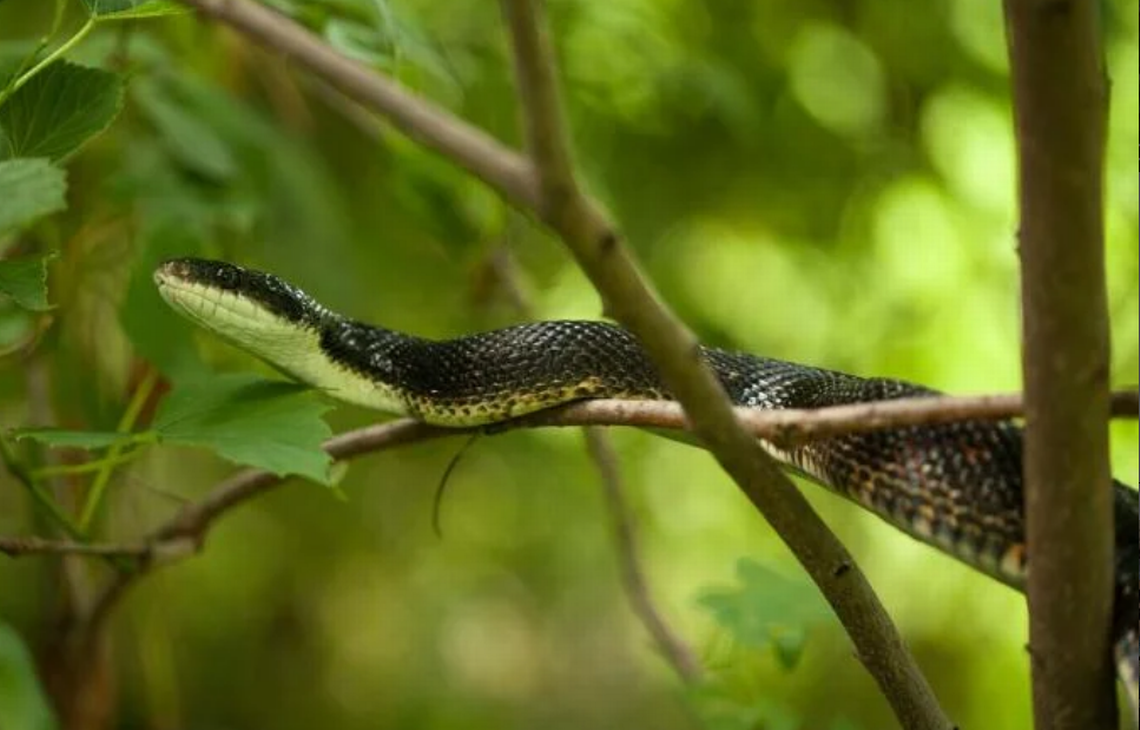Missouri is home to 43 types of snakes, with around 27 varieties found in the Kansas City area. They range in size from the tiny 7-inch Flat-Headed Snake to the Bullsnake, which can reach up to six feet in length.
Whether you’re afraid of snakes or have a love for slithering creatures, here are a few pointers for how to coexist with them if you see one this spring.
What types of snakes can be found in Kansas City?
By far the most common type of snake found in Missouri, including in the Kansas City area, is the Western Ratsnake — also called the Black Ratsnake or just the Black Snake, said Jeff Briggler, who has served as Missouri’s state herpetologist for 23 years.
This variety is one of the state’s largest snakes, often measuring three to four feet in length but able to grow up to six feet.
Other common snakes in the Kansas City area include the Yellow-Bellied Racer, the Prairie Kingsnake, the Speckled Kingsnake and the Eastern Garter Snake, Briggler told The Star. Fortunately, none of these snakes are venomous.
“The geography of Missouri that we live in, we’ve got the forest meeting the grasslands, so we have a good diversity of snakes in a variety of sizes,” he added. “Their habits and behaviors all vary significantly, so it makes them interesting and unique in a way.”
Are any of Kansas City’s snakes venomous?
Briggler told The Star that only two types of venomous snakes live in the Kansas City area. The first is the Eastern Copperhead, the most common venomous snake in Missouri. This chubby snake is tan with hourglass-shaped brown splotches often edged in white and is usually around two to three feet long.
The Timber Rattlesnake is the other venomous snake found in the area. It has a distinctive pattern of dark v-shaped bands and a rattle on its tail that it uses to make a buzzing sound when alarmed. However, a rattle isn’t always a dead giveaway that you’re dealing with a venomous snake.
“Do not rely on a rattle sound for identification,” the Missouri Department of Conservation advises. “Remember that snakes’ tails are occasionally injured or cut off and that a surprised snake may not have time to sound its rattle.”
Briggler added that some non-venomous snakes may also attempt to imitate rattlesnakes when threatened.
“Some of our common snakes vibrate their tails (to) try to threaten you — they want to act like a rattlesnake,” he said. “Sometimes when a common non-venomous snake, like a rat snake, vibrates his tail and he’s hitting leaves, that can sound sometimes like a rattle, but it’s really not.”
What should you do if you see a snake?
Briggler advised taking a “live and let live” approach to any snakes you encounter in the wild.
“It’s best just to avoid them and let them move on their merry way,” he said. “Just like you have your path, your house and home, they have their path and places they go. So it’s just best to leave them alone and walk around them and move on.”
Snakes aren’t found as often in densely urban areas as they are in rural barns and wooded areas, but it’s still possible to find a snake in a public park or a highly trafficked neighborhood.
If a snake is in harm’s way, like on a busy street or lounging on a public sidewalk, Briggler said that it’s fine to nudge it with a stick or even pick it up with your hands to move it to safety — as long as you’re sure it’s not venomous. But he added that most snakes will keep away from human-made hazards on their own.
The moderate temperatures of the spring and fall make them the most likely times to see snakes during the day, Briggler said. In the heat of summer, they often shelter during the day and become more active at dawn, dusk and nighttime.
He added that it’s important to be familiar with the venomous snakes in your area and to appreciate the impacts that local snakes have on your environment.
“The majority of our snakes are very beneficial,” he said. “If you don’t want rodents (and other) stuff around your house, it’s good to have the snakes.”
What should you do if a snake bites you?
Very few snake bites are reported in Missouri, and even fewer come from venomous snakes, Briggler said.
“Most bites occur when someone sees a venomous snake and decides to handle or kill the snake,” Briggler and retired herpetologist Tom R. Johnson wrote in “A Guide to Missouri’s Snakes,” a reference booklet published by the state’s Department of Conservation.
“During such scenarios, the venomous snake will do its best to defend itself,” the guide continues.
If you are bitten, the booklet advises remaining calm, removing tight clothing and jewelry from the bitten area, and seeking medical attention. Even if you don’t think the snake is venomous, it’s best to seek medical attention for the bite to make sure.
If you can safely do so, Briggler recommends getting a photo of the snake that bit you or having a friend try to do so. A photo or detailed description can help first responders identify whether the snake was venomous. But using first aid measures you may have heard about in popular culture should be avoided.
“Applying a tourniquet, cutting and sucking out the venom, applying ice packs, electric shock therapy, or consuming alcohol or caffeinated drinks are not recommended for snakebites,” Briggler and Johnson wrote.
Do you have more questions about wildlife or sustainability in Missouri or Kansas? Ask the Service Journalism team at kcq@kcstar.com.
